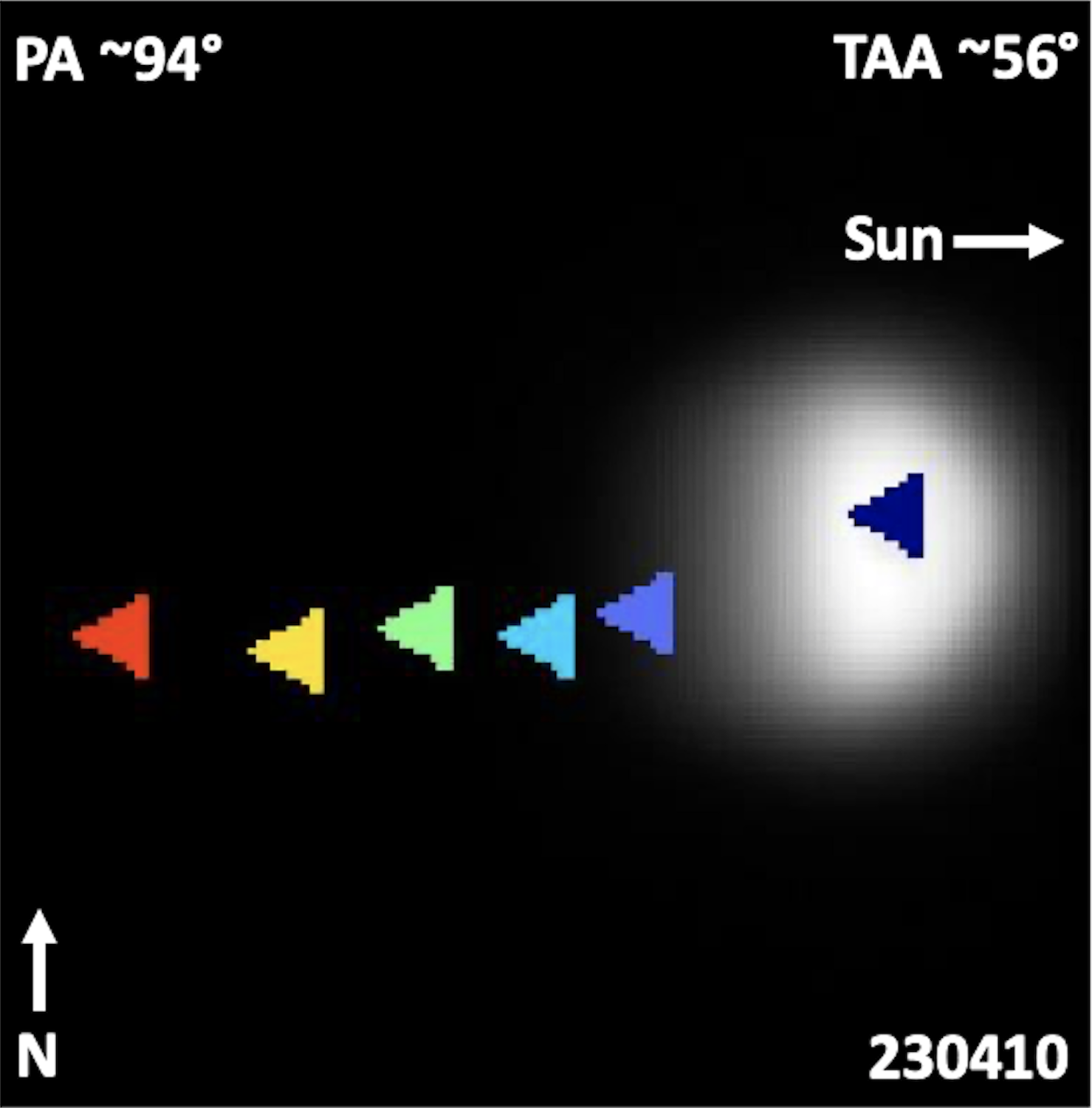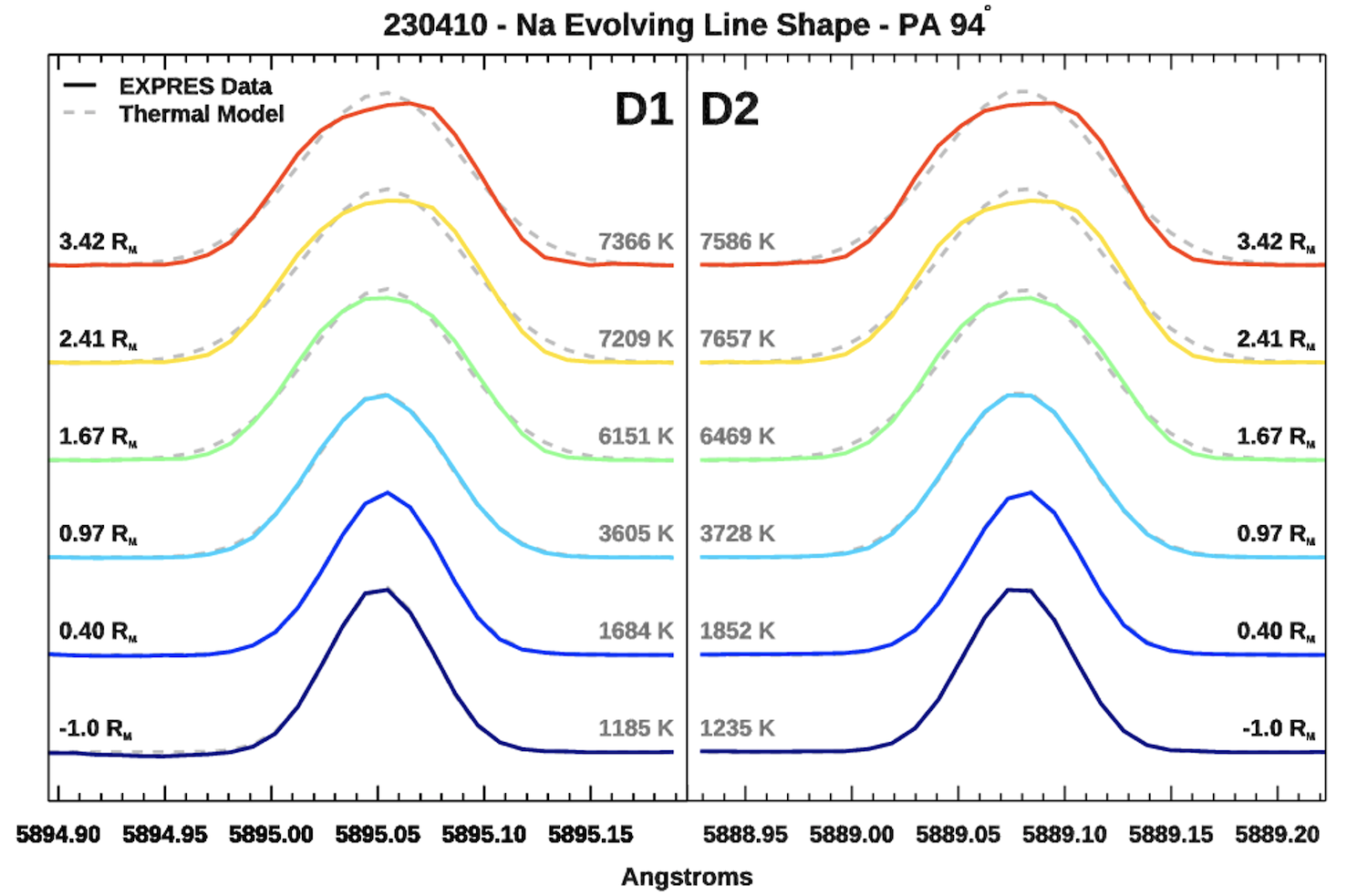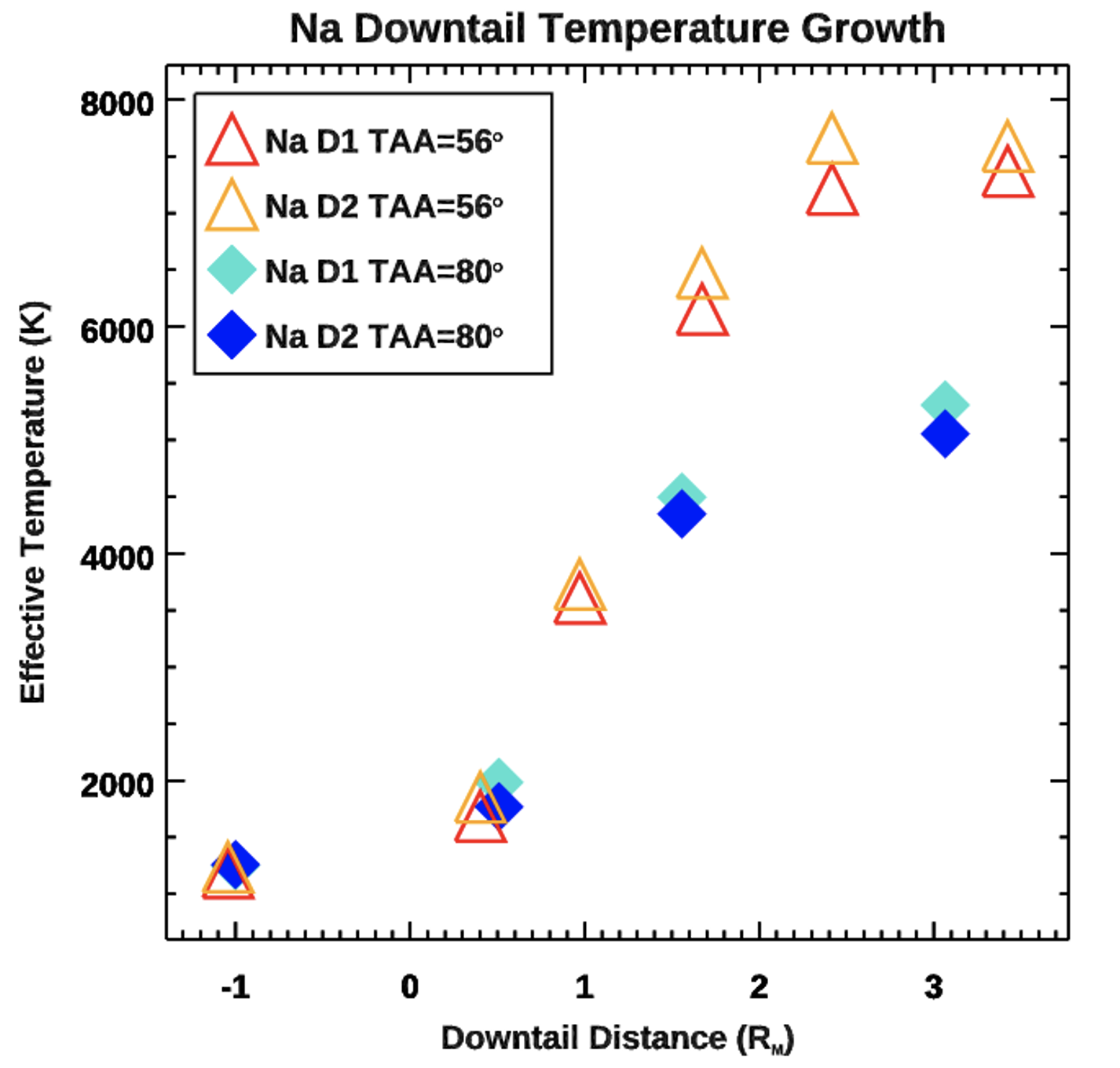- Center for Space Physics, Boston University, Boston, USA
Sunlight can shape elements in Mercury’s thin atmosphere into an escaping cometlike tail. Solar photons are absorbed from one direction—the Sun—and scatter isotropically, imparting a net momentum in the anti-sunward direction. This change in momentum is a force that is strongest on atoms that efficiently interact with sunlight, that is, atoms with strong resonance scattering like sodium and potassium. Sunlight is intense at Mercury, and this creates a long sodium tail that extends more than 1000 planetary radii, making it one of the largest structures in our solar system [1].
Precision radial velocity spectrometers are common tools in the exoplanet community that can offer resolved linewidth measurements of Mercury’s exosphere. Here we present observations of the sodium and potassium exosphere from two such instruments. With R~150,000 resolving power and fast tip-tilt image stabilization, the Extreme Precision Spectrometer (EXPRES) at the 4.3m Lowell Discovery Telescope is ideally suited for measuring line broadening in planetary gases [2][3][4]. Over several nights across April 2023, we sampled from 0 to 4 planetary radii along the cometlike tail with EXPRES. Data were obtained surrounding maximum radiation pressure (TAA = 56–80°) and at a 90° phase angle, where Mercury’s tail is oriented perpendicular to the line of sight. Our downtail pointing from 2023 April 10 is illustrated in Figure 1. In addition to probing the exotail, we also acquired spectra on disk to look for small-scale variations in linewidths. In March 2024, we completed a follow-up campaign with the Keck Planet Finder (KPF) spectrometer on the Keck I telescope, once again sampling several planetary radii downtail and more intentionally targeting on-disk regions of interest (cusps, subsolar point, poles, etc.). This run spanned a different season at Mercury (TAA = 20–40°) with the planet still near 90° phase angle. Results from EXPRES are discussed herein and early results from the follow-up KPF campaign will be presented in-person at EPSC2024.
In order to quantify measured linewidths, we derive effective temperatures. While the collisionless exosphere is not inherently thermal, effective temperature estimates are nonetheless a useful energy metric. We obtain these estimates by convolving forward models of the Doppler-broadened hyperfine structure of the sodium and potassium D lines with the instrumental line spread functions of EXPRES and KPF. These convolved models are fit to the solar-subtracted spectra and best-fit temperatures are extracted via a least-squares algorithm. Pointing is determined by matching spectra to slit-viewer images. As verification of this method, we measure sodium gas above the low-latitude dayside limb to be approximately 1200K, consistent with estimates derived from MESSENGER scale heights [5].
We find that both sodium and potassium line profiles exhibit steep growth with downtail distance until their effective temperatures level off near 8000 and 10,000 K, respectively, around 3 planetary radii. We interpret this to be the furthest extent of gravitationally bound gas, where atomic trajectories reach apex and return toward the surface. Beyond 3 radii, the escaping gas populations show a constant effective temperature with distance. Figure 2 shows sodium D1 and D2 profiles from 2023 April 10. As we point downtail, the gravitationally trapped cold population forming the core of the lines is depleted, causing broadening and producing the nonthermal profiles seen past 1.5 radii. The asymmetry in these sodium profiles is consistent across nights and appears to indicate more particles are moving away from us than toward us along the line of sight. Figure 3 plots the leveling off of effective temperature at two TAAs. At maximum radiation pressure, the effective temperature of the distant tail approaches 8000 K, as compared to 5000 K during a lower g-value season. This is expected, as radiation pressure accelerates particles to higher velocities during the peak g-value season. The potassium exosphere is less extended than sodium at only ~700 K above the dayside limb, but both species exhibit significant escape during peak radiation pressure.
Results from on-disk measurements with EXPRES show that sodium above the low-latitude dayside limb is approximately 1200 K, while gas at high latitudes is 100-200 K more energetic. Despite bright enhancements near the magnetic cusps, linewidths here show no evidence for an ion-sputtered component with energies predicted by theory or laboratory time of flight experiments. KPF measurements will help further constrain the contribution of a hot sputtered component. A cold population with enhancement at the cusps may suggest a plasma-stimulated low-energy exospheric source such photon or electron stimulated desorption.

Figure 1: EXPRES pointing on 2023 April 10 with triangles representing the spectrometer aperture. We sampled the southern lobe of the tail from 0 to 4 radii downtail.

Figure 2: EXPRES line profiles of sodium D1 and D2 at increasing downtail distance from Mercury. Spectra are color-coded to match pointing locations in Figure 1. Data are overlaid with thermal forward models in grey, illustrating how, as linewidths grow, they also become increasingly nonthermal. Best fit temperatures are given in grey. Downtail distances are zeroed at the nightside limb. Temperatures increase from ~1200K on disk to above 7000K past 3 Mercury radii downtail.

Figure 3: Sodium best-fit temperatures to EXPRES data as a function of downtail distance for two true anomaly angles. Temperature levels off just before 3 Mercury radii downtail for both, though effective temperatures far downtail are much higher for TAA=56°.
References:
[1] Baumgardner, J., Wilson, J., & Mendillo, M, 2008, GRL, 35(3), L03201.
[2] Petersburg R. R., Joel Ong J. M., Zhao L. L. et al. 2020 AJ 159 187.
[3] Jurgenson C., Fischer D., McCracken T. et al. 2016 Proc. SPIE 9908 99086T.
[4] Brewer J. M., Fischer D. A., Blackman R. T. et al. 2020 AJ 160 67.
[5] Cassidy, T. A., Merkel, A. W., Burger, M. H., et al., 2015, Icarus, 248.
How to cite: Lierle, P., Schmidt, C., and Lovett, E.: Linewidth Measurements of Mercury's Alkali Exosphere, Europlanet Science Congress 2024, Berlin, Germany, 8–13 Sep 2024, EPSC2024-757, https://doi.org/10.5194/epsc2024-757, 2024.